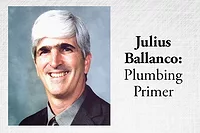What Is Ecoflex?
As all of you know by now, ISH will be held this month in Frankfurt, Germany. As you also know, PM is a sponsor of the special sold-out trip to ISH.
What you probably don’t know is anything about the other sponsor of the trip — Ecoflex. Many of the readers have asked me, “What is Ecoflex?” or “Who is Ecoflex?” or “Is it a product, name or company?” Ecoflex is a company name; however, in the United States, it also refers to the product.
Ecoflex — The Product: I first encountered Ecoflex on my trip to ISH two years ago. Ecoflex is a preinsulated plastic pipe. I thought it was rather neat. We have all seen preinsulated steel pipe or copper tubing. But plastic — what an idea.
There are three main product lines available in the United States. The most popular product is the Ecoflex Thermo Single. The inner pipe, referred to as the carrier pipe, is PEX tubing. The PEX happens to be Wirsbo tubing, rated for potable water by NSF. The second line of product is the Thermo Twin. This one has two PEX pipes in the middle of the insulation.
The third line is called Supra. Supra is different in that the carrier pipe is high density polyethylene (HDPE). Since the carrier pipe is polyethylene, it is limited to temperatures below negative 120 degrees F. The Supra also comes with a self-limiting, heat-tracing cable preinstalled on the inside of the pipe. The heat-tracing cable can provide either freeze protection or maintenance of water temperature. By being self-limiting, the heat-tracing cable only uses electricity when the temperature drops below the setting of the cable.
Most of you are probably used to seeing PEX tubing in smaller diameters, such as 3/8, 1/2 and 3/4 inches. Although it is recognized that PEX is available up to 2 inches in size, the majority of the pipe installed is 1 inch or smaller in diameter. That is where Ecoflex is different. The smallest size pipe for Ecoflex is 1 inch in diameter. It goes up to 4 inches in diameter, with intervening sizes of 1-1/4, 1-1/2, 2, 2-1/2, 3, 3-1/2 and 4 inches. When’s the last time you saw a 3-1/2-inch pipe?
Being larger in diameter, the predominant use of Ecoflex is in commercial construction, not residential, like other PEX pipe. That is not to say you couldn’t use Ecoflex in residential construction. As a matter of fact, I see an ideal use for Ecoflex in residential construction for the main piping off a boiler. Imagine running the supply and return together with the insulation wrapped around both pipes. That is what you get with a Thermo Twin. Hence, the labor savings is tremendous when you figure that one pipe installs two systems. On top of that, the pipe is flexible, eliminating the need for fittings to make changes in direction.
If you check the ads Ecoflex is running, you will see the pipe being recommended for outside, underground installations. For district heating, when a boiler plant in one building supplies numerous buildings, Ecoflex is an ideal piping material. You can trench around any obstruction without a lot of problems. It comes in coils anywhere from 328 to 656 feet in length. The pipe will bend and snake in whatever trench is provided. It is sometimes hard to imagine a 4-inch, preinsulated pipe that is flexible.
Another outside, underground in-stallation would be the supply and return to snowmelting systems. Ecoflex can be used to connect to the radiant piping used for snowmelting. The pipe would reduce the energy loss in the intervening pipe, or perhaps a water-service pipe with a built-in freeze protection system. (Think of how difficult it is to unfreeze a plastic water service pipe otherwise.)
I consider the outside, underground piping market to be a small part of the use of Ecoflex. When I first encountered the pipe, I envisioned it being used in commercial construction for anything from hot and cold water distribution, hot water (heating) supply and return, chilled water systems and process piping. Most engineers are requiring piping systems inside the building in commercial construction to be insulated. Well, Ecoflex is already insulated. Hence, you save time and money by using a preinsulated PEX tubing rather than an insulated copper or steel system.
The fittings for joining Ecoflex are also unique. They have an external compression connection. Hence, the full bore of the pipe is maintained. There is also a covering that allows the insulation aspect of the pipe to be maintained.
Whenever I encounter a new piping material, I attempt to list all of the good points, as well as all of the bad points. You have heard most of the good points, so you may be asking, “What is the down side of Ecoflex?”
As a flexible plastic pipe, the hanger spacing is reduced when installed inside a building. Ecoflex recommends a spacing of 40 inches. Another problem is that the PEX tubing is based on the metric sizes as opposed to the American sizes.
The metric sizes, however, are not that big of a deal to me. Any connection to other piping materials is made with adapter fittings, which have threaded connections. If you properly size a system, you use the available inside diameter of the pipe that is being installed. For Ecoflex, the same thing would apply.
Looking for a reprint of this article?
From high-res PDFs to custom plaques, order your copy today!






